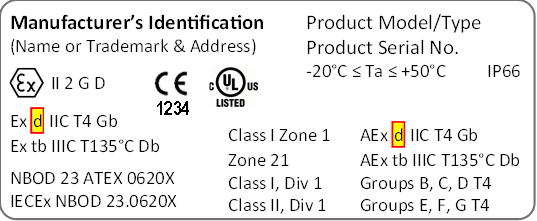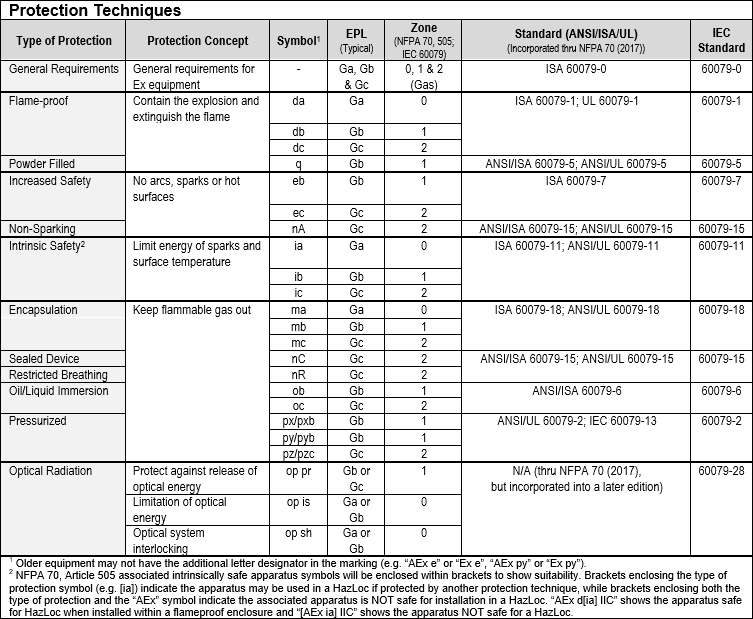The Drill Down, Issue #26: Hazardous Location Electrical Markings - Protection Techniques
 Introduction
Introduction
This edition on Hazardous Location (HazLoc) electrical equipment markings will discuss the protection techniques utilized by National Fire Protection Association (NFPA) 70 (National Electric Code (NEC)) and the International Electrotechnical Commission (IEC) 60079-series. Quotes from standards are shown in italicized font.
 |
| Figure 1: Equipment label with protection techniques indicated for IEC (left) and NFPA 70, Article 505 (right) |
NFPA 70, Article 500
Article 500 of NFPA 70 (2017) does include protection techniques (500.7), but marking the same on the equipment or its label is NOT required under this system.
NFPA 70, Article 505
The protection technique is a required marking for Article 505 equipment. The “d” in the “Class I Zone 1 AEx d IIC T4 Gb” Article 505 marking in Figure 1 shows the protection technique to be flameproof (“d”).
NFPA 70 (2017), Article 505 contains 9 protection techniques (defined at 505.2 with allowable locations stipulated by 505.8)[1]:
Flameproof “d” – Type of protection where the enclosure will withstand an internal explosion of a flammable mixture that has penetrated into the interior, without suffering damage and without causing ignition, through any joints or structural openings in the enclosure, of an external explosive gas atmosphere consisting of one or more of the gases or vapors for which it is designed. “d” is permitted for equipment in Class I, Zone 1 or 2 locations.
Increased Safety “e” – Type of protection applied to electrical equipment that does not produce arcs or sparks in normal service and under specified abnormal conditions, in which additional measures are applied so as to give increased security against the possibility of excessive temperatures and of the occurrence of arcs and sparks. “e” is permitted for equipment in Class I, Zone 1 or 2 locations.
Intrinsic Safety “i” – Type of protection where any spark or thermal effect is incapable of causing ignition of a mixture of flammable or combustible material in air under prescribed test conditions. “i” is permitted for apparatus and associated apparatus in Class I, Zone 0, 1 or 2 locations for which listed.
Encapsulation “m” – Type of protection where electrical parts that could ignite an explosive atmosphere by either sparking or heating are enclosed in a compound in such a way that this explosive atmosphere cannot be ignited. This protection is further subdivided into ma, mb, and mc and is permitted for equipment in Class I, Zone 0, 1 or 2 locations for which it is identified. Only ma is allowed in Zone 0.
Type of protection “n” – Type of protection where electrical equipment, in normal operation, is not capable of igniting a surrounding explosive gas atmosphere and a fault capable of causing ignition is not likely to occur. This protection is further subdivided into nA, nC, and nR and is permitted for equipment in Class I, Zone 2 locations.
Oil Immersion “o” – Type of protection where electrical equipment is immersed in a protective liquid in such a way that an explosive atmosphere that may be above the liquid or outside the enclosure cannot be ignited. “o” is permitted for equipment in Class I, Zone 1 or 2 locations.
Pressurization “p” (referred to as “purged and pressurized” in earlier editions of NFPA 70) – Type of protection for electrical equipment that uses the technique of guarding against the ingress of the external atmosphere, which may be explosive, into an enclosure by maintaining a protective gas therein at a pressure above that of the external atmosphere. “p” is permitted for equipment in Class I, Zone 1 or 2 locations for which identified.
Powder Filling “q” – Type of protection where electrical parts capable of igniting an explosive atmosphere are fixed in position and completely surrounded by filling material (glass or quartz powder) to prevent the ignition of an external explosive atmosphere. “q” is permitted for equipment in Class I, Zone 1 or 2 locations.
Combustible Gas Detection System: A protection technique utilizing stationary gas detectors in industrial establishments. This is not a typical protection technique utilized on vessels or OCS units, although gas detection is typically installed as a warning system and may be required as such by separate regulatory and/or international conventions or codes. While this is considered as the 9th protection technique under this standard, it does not have a letter code or symbol like the previously mentioned techniques. See NFPA 70 (2017), 505.8(I) for additional information on this technique.
IEC 60079-Series
IEC 60079-0 states that protection techniques shall be included with the equipment marking. The “d” in “Ex d IIC T4 Gb” in Figure 1 shows the IEC protection technique to be flameproof (“d”).
Definitions from the “part” of IEC 60079 for the respective protection technique follow. IEC 60079-0 (2017) and the individual standards for the protection types incorporate an additional character, related to the Equipment Protection Level (EPL), that may not be present in older equipment markings (see Drill Down #28 for the EPL discussion). An example of a protection technique subdivision marking is “Ex db IIC T4 Gb”.
Flameproof Enclosure “d” – enclosure in which the parts which can ignite an explosive gas atmosphere are placed and which can withstand the pressure developed during an internal explosion of an explosive mixture, and which prevents the transmission of the explosion to the explosive gas atmosphere surrounding the enclosure (IEC 60079-1 (2014), Clause 3.1). Type “d” equipment shall be “da” for EPL Ga, “db” for EPL Gb or “dc” for EPL Gc (Article 4.1)[2].
Increased Safety “e” – type of protection applied to electrical equipment or Ex Components in which additional measures are applied so as to give increased security against the possibility of excessive temperatures and against the occurrence of arcs and sparks (IEC 60079-7 (2017), Clause 3.5). Type “e” equipment shall be “eb” for EPL Gb or “ec” for EPL Gc (Article 4.1)[2].
Intrinsic Safety “i” – type of protection based on the restriction of electrical energy within equipment and of interconnecting wiring exposed to the explosive atmosphere to a level below that which can cause ignition by either sparking or heating effects (IEC 60079-11 (2011), Clause 3.1.1). This type of protection is designated by levels of protection “ia”, “ib” or “ic” by Article 5.
Encapsulation “m” – type of protection whereby parts that are capable of igniting an explosive atmosphere by either sparking or heating are fully enclosed in a compound or other non-metallic enclosure with adhesion in such a way as to avoid ignition of a dust layer or explosive atmosphere under operating or installation conditions (IEC 60079-18 (2017), Clause 3.1). This type of protection is further designated by EPL as “ma” for EPL Ga, “mb” for EPL Gb or “mc” for EPL Gc by Article 4.1)[2].
Type of protection “n” – type of protection applied to electrical apparatus such that, in normal operation and in certain specified regular expected occurrences, it is not capable of igniting a surrounding explosive gas atmosphere (IEC 60079-15 (2017) 3.7. “nC” can denote a hermetically-sealed device, non-incendive component or a sealed device IAW article 3.1 and “nR” denotes a restricted-breathing enclosure IAW article 3.2. Equipment built to earlier editions of the standard may also be designated as “nA” for a non-sparking device or “nC” for an enclosed-break device. All type “n” protection techniques are associated with EPL Gc (IEC 60079-0 (2017), Clause 29.4).
Liquid Immersion “o” (previously known as oil immersion) – type of protection in which the electrical equipment or parts of the electrical equipment are immersed in a protective liquid in such a way that an explosive gas atmosphere which may be above the liquid or outside the enclosure cannot be ignited (IEC 60079-6 (2015), Clause 3.1). “Protective liquid” is defined as liquid which prevents the explosive atmosphere from making direct contact with potential ignition sources at article 3.2. Type “o” equipment shall be “ob” for EPL Gb or “oc” for EPL Gc (Article 4.2)[2].
Pressurization “p” – technique of guarding against the ingress of the external atmosphere into an enclosure by maintaining a protective gas therein at a pressure above that of the external atmosphere (IEC 60079-2 (2014), Clauses 3.13 and 4). “Protective gas” is defined as air or inert gas at article 3.16 of the standard (IEC 60079-2). Pressurization is subdivided into types pxb, pyb and pzc (equipment constructed under earlier editions of this standard will not have the third letter (EPL related designation) (i.e., px, py and pz).
“pxb” – pressurized enclosure providing EPL Mb, Gb or Db (IEC 60079-2 (2014), Clause 3.20).
“pyb” – pressurized enclosure providing EPL Gb or Db with EPL Gc or Dc internal to the pressured enclosure (IEC 60079-2 (2014), Clause 3.21).
“pzc” – pressurized enclosure providing EPL Gc or Dc (IEC 60079-2 (2014), Clause 3.22).
“px” – pressurization that reduces the classification within the pressurized enclosure from Zone 1 to non-hazardous or Group I to non-hazardous (IEC 60079-2 (2001), Clause 3.21).
“py” – pressurization that reduces the classification within the pressurized enclosure from Zone 1 to Zone 2 (IEC 60079-2 (2001), Clause 3.22).
“pz” – pressurization that reduces the classification within the pressurized enclosure from Zone 2 to non-hazardous (IEC 60079-2 (2001), Clause 3.23).
Powder Filling “q” – type of protection in which the parts capable of igniting an explosive gas atmosphere are fixed in position and completely surrounded by filling material to prevent the ignition of an external explosive gas atmosphere (IEC 60079-5 (2015) 3.1). “Filling material” is defined as solid quartz or solid glass particles at article 3.2. Type “q” protection techniques are associated with EPL Gb (IEC 60079-0 (2017), Clause 29.4).
“s” – This marking has a different meaning, based on the age of the equipment and standard utilized for equipment construction:
1) Considered safe by a national or other authorized body, but does NOT conform with 60079-0 (2000) Clause 1 (27.2.d and Note 2 to Clause 1)[3], or
2) Special protection (IAW IEC 60079-33) further designated as “sa”, “sb” or “sc” for EPLs Ga, Gb or Gc, respectively.
Conclusion
While not a required marking for NFPA 70, Article 500 equipment, protection techniques are a required marking for NFPA 70, Article 505 and IEC equipment. Updated editions of the applicable standards vary the marking designations and specific protection techniques may only be allowed in certain Zones. See the appendix for summarized references.
The next Drill Down on HazLoc electrical equipment markings will address temperature classes.
[1] Several of the protection techniques are subdivided in the 2017 edition. The additional letter for the type of protection symbol did not exist in earlier editions of the standard or for equipment built to those standards.
[2] The additional letter for the type of protection symbol did not exist in earlier editions of the standard or for equipment built to those standards.
[3] Equipment marked with this designation should not be accepted for equipment that is required to comply with the IEC standard.
Appendix
Protection Techniques Reference Chart
NFPA 70, Article 505; IEC 60079-Series

